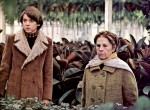Images of Vietnam washed across newspapers. Starry-eyed college kids with flowers in their hair staged demonstrations across the country. America was in flames and the revolution was televised.
In the clink and clamor of war and protest during the late 1960s and early 1970s, Hollywood cinema started to change with the rest of the country. The days of the virginal Doris Day and the hyper-masculine Rock Hudson were no more. The Old Hollywood studio system was dead. Reflecting the large-scale social problems of the era, the earth-shattering and politicized cinematic musings of the New Hollywood promised insight into a no longer innocent American youth.
One of the films to be released during this period was Hal Ashby’s 1971 classic “Harold and Maude,” which will be playing at the Nuart Theatre this Valentine’s Day just before midnight. Set to the iconic pop folk music of Cat Stevens, “Harold and Maude” chronicles a helpless, hopeless love story set within an America still reeling from a futile war.
“Harold and Maude” focuses on a romance between two people from two completely different generations. Harold (Bud Cort) is a directionless 20-something who thinks about death. In between faking his own suicide by gunshot, hanging and disembowelment, the morbid Harold spends his time watching funerals. While attending one, he meets the carefree and vivacious 79-year-old Maude (Ruth Gordon). A friendship and eventual love affair ensue, seemingly defying the generational gap.
The film began its life as screenwriter Colin Higgins’s master’s thesis for UCLA’s film school. After several false starts, it finally fell into the lap of Hal Ashby, a rising director who had won an Oscar for editing “In the Heat of the Night” but had only directed one film before, the largely forgotten “The Landlord.”
Though made on a budget of only slightly more than a million dollars, “Harold and Maude” would end up solidifying Ashby’s status as one of the great filmmakers of his day, and would allow him to make a series of groundbreaking movies over the next decade, including “Shampoo” and “Coming Home.” However, “Harold and Maude” still stands as one of his greatest achievements.
It’s a film that could not have been made previously. Darkly comical and unconventional in its dealings with such an unusual relationship, “Harold and Maude” captures the disillusionment and desires of a generation of young adults that would have been deemed too deviant and political to be put onto the screen in the past.
In much the same way as the meandering, goalless character Benjamin Braddock in Mike Nichols’ “The Graduate,” Harold feels the alienation similarly felt by the rest of his generation and lacks any sort of clarity in his life. The disconnect between himself and the world around him makes the film as relevant now as it was some forty odd years ago.
Today, “Harold and Maude” is considered one of the greatest productions to come from New Hollywood. Its real strength is that despite its shocking subject matter and the unexpected relationship between the two central characters, the film establishes a connection between the audience and the couple. It is simultaneously a product of the era in which it was made and an everlasting love story.
What locally screened films do you think deserve their time in the spotlight?
